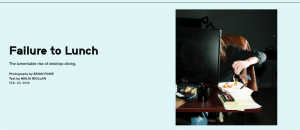Thank you, Cathy Kroll, for writing me detailed feedback for my Ethnography Assignment. This gives me a perfect time to reflect (and a perfect excuse for a blog entry). Rather than becoming more aware of others, I became acutely aware of myself. Ethnographic observation is difficult. It’s real time and fast moving. We are photographers, […]
Thank you, Cathy Kroll, for writing me detailed feedback for my
Ethnography Assignment. This gives me a perfect time to reflect (and a perfect excuse for a blog entry).
Rather than becoming more aware of others, I became acutely aware of myself. Ethnographic observation is difficult. It’s real time and fast moving. We are photographers, posed to capture the golden moments at a gathering, but those moments — all happening simultaneously — get framed seconds too late, captured too blurry. And while the imperfect moments are still perfect in their own right, I could have observed it
better.
That’s why I fell so heavily into my own training and mode of thinking at the Flamingo. I observed age since age is what made me the fish-out-of-water. I gravitated toward the dance floor rather than the bar or the tables. I made no mental notes about the band; their clothes, their movements and their use of space were invisible to me. Yet the singles (those who were not blending) caught my attention. My own cognitive biases glared at me when I sat to write.
Dr. Kroll’s feedback helped me see that I can leave these insecurities behind. Rather, I should suspend my fear of tarnishing objectivity and take my observations further — explore the
why. I need to ask questions and pose answers about my subjects’ motivations. I only started at observation; I didn’t analyze.
Despite those shortcomings, my assignment was a success. But I know it wouldn’t have been
as much of a success if I had walked in with no previous experience. Just about
the entirety of my job experience fed into my finished Ethnographic Assignment.
My previous training:
- Before I was a literature MA student, I was a creative writing student at SFSU, focusing in creative nonfiction. Surprise?
- After I received my BA in creative writing, I worked as a blogger for a software marketing company in Silicon Valley. There, I learned that (readable) blogs need…
- Lists
- Frequent headers
- Short-short paragraphs …All of this I use in this blog.
- When I chose to move back to Santa Rosa, I began a career in web development, where I met amazing designers who taught me how to find great royalty-free photography (hence, these spectacular header images).
I feel that, without my experiences leading up to this point, my trip to the Flamingo would have turned into a drastically different piece, despite our reading. That’s the scary part of this work. And that’s where I am determined to break out of my mold and grow.



